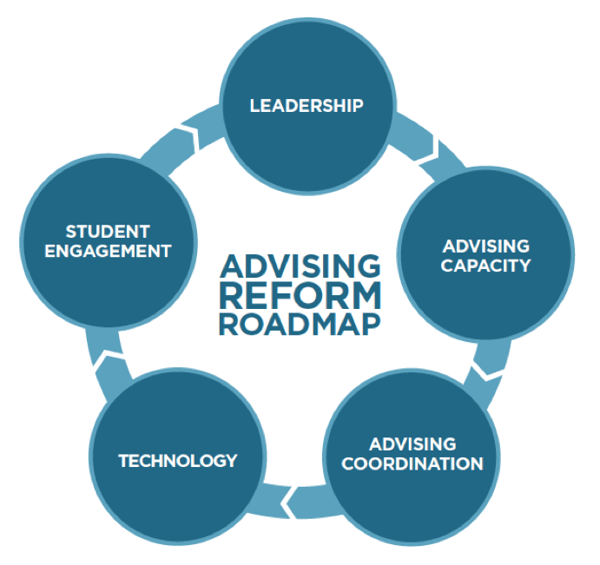Published on
Moving Leadership Beyond Empty Mandates: The Road to Improved Academic Advising (Part 1)

Higher education has a big problem: Students aren’t crossing the finish line. According to the National Center for Education Statistics (NCES), only 60 percent of students who begin their pursuit of a bachelor’s degree actually go on to complete their degree program. At community colleges, that number is even worse: around 29 percent. Financial, family and other life challenges often stall students on their drive toward a degree even more than academic woes, especially for the growing population of non-traditional students. There is a great need for institutions to find ways to increase student degree program completion, and one of the most impactful levers is an effective student planning and advising unit.
In a report Tyton Partners released in June, Driving toward a Degree: Establishing a Baseline on Integrated Approaches to Planning and Advising, we surveyed over 1,000 higher education leaders with active involvement in advising, and we found that the vast majority of institutional stakeholders believe their advising units aren’t succeeding. Less than 20 percent of administrators believe their institutions “achieve an ideal advising situation for their students.” Despite these challenges, the insights from our report revealed a roadmap for institutions to improve their planning and advising function. Institutions are at various points on the road to a well-oiled advising unit, and our “Advising Reform Roadmap” is a tool that stakeholders can use to figure out where to begin to improve effectiveness.
This post is the first in a five-part series featuring each of the intervention areas along the Advising Reform Roadmap. Throughout the series we will highlight the current landscape of academic planning and advising, challenges institutions face, approaches institutions of all types are taking, and actionable steps higher education leaders and administrators can take toward an ideal advising situation for their students.
We start with leadership—where advising reform begins for many institutions. Leadership in planning and advising is broader than a mandate for change from top administrators. While more than 80 percent of stakeholders we surveyed said student retention is a primary objective in their strategic plan, our research shows that it takes more than a sound strategy to enact change.
According to Charlie Nutt, Executive Director of NACADA, effective leadership occurs when “there is a campus-wide culture and a campus-wide focus on advising.” Unfortunately, Nutt continued, that’s still missing on most campuses.
So how can institutions improve the leadership around planning and advising on their campuses? Here are a few places to start.
1. Commit to Organizational Change
First and foremost, institutional leaders must make a commitment to change if they want to see improved student outcomes. This might start with strategic visioning—82 percent of surveyed institutions agree that student retention is a primary objective in their institution’s strategic plan—but this is only the beginning.
Transformational change to an institution’s planning and advising unit requires a commitment from institutional leadership to set up the right structures for it to succeed.
Nutt says that the first step to establishing a campus-wide culture and commitment to advising is “some type of advising council or network that has representation from around campus.” The council should meet regularly to discuss “campus wide goals for advising, mission statement, and how to best use technology to support students.”
Setting up a network for advising can illustrate a commitment on behalf of university leadership, and establish buy-in on advising initiatives on all corners of the campus.
2. Establish a Clear Structure of Accountability
Following a commitment on behalf of leadership to executing organizational change, the next step is accountability. While several organizational models are observed in institutional planning and advising units, clear ownership of advising initiatives is one of the most common qualities in institutions succeeding in advising reform. According to an institutional segmentation from our research, 83 percent of “Equipped Navigators”—or institutions who are furthest along in achieving advising reform success—agree that their institution commits to ensuring there is clear ownership for student success and retention initiatives, compared to just 45 percent for institutions overall.
Importantly, clear ownership does not imply a specific organizational model. Just 62 percent of Equipped Navigators report institutional centralization at their institutions, implying that over a third of institutions that are achieving advising success are not centralized. Additionally, 51 percent of Equipped Navigators indicated that there is one individual with overall responsibility for advising, suggesting that there is a shared ownership structure for planning and advising at almost half of the high performers.
George Mason University (GMU) is one institution with this decentralized model for advising. Jeannie Brown Leonard, Dean of Student Academic Affairs–Advising, Retention and Transitions at GMU, said one of her greatest challenges with decentralization is that she “has a responsibility to improve advising, but no authority to improve advising.” To establish accountability, Brown Leonard has built relationships with deans and identified a champion at each GMU school or college to both drive the campus-wide vision for advising and disseminate information.
Institutions should find an organizational model and ownership structure that works at their institution—with the key being clear accountability for moving advising initiatives forward.
3. Expand the Scope of Leadership Beyond Administrators
Many institutions who are succeeding with their advising reform initiatives are working to ensure that the vision for these initiatives is shared across the organization, including with project and initiative leaders. In an August 2015 white paper, Leadership for Transformative Change: Lessons From Technology-Mediated Reform in Broad-Access Colleges, Serena Klempin and Melinda Karp from the Community College Resource Center (CCRC) wrote, “transformative change requires multi-tiered leadership with shared priorities and a unified commitment to the goals of reform.”
Including project-leaders and leaders of individual planning and advising initiatives can help to build this sense of unified commitment among the entire staff. At University of Washington (UW), Associate Dean of Undergraduate Academic Affairs Jason Johnson has helped to establish a UW “Advising Academy” to signal that advisors “need to be at the table and in the driver’s seat” for advising initiatives. As part of this initiative, advisors are selected through an application process to provide campus leadership and feedback on advising initiatives, including working with IT on the design and implementation of advising tools.
Some institutions even include students on their planning and advising leadership teams. According to Brown Leonard at GMU, students can “offer a candid perspective and often are willing to go back to their peer groups to float ideas for feedback.” At GMU, two students were included on the planning and advising leadership team this past year.
All that said, it is not enough to simply share ownership. All tiers of planning and advising leadership must have a shared vision for advising reform. Klempin and Karp note that it is optimal if both levels of advising reform leadership, institutional and project level, share an adaptive vision for leadership. This approach requires “leaders who can motivate people to engage in difficult conversations and to think and act differently.”
Administrators and initiative leaders should seek to embody this approach to inspire engagement in advising reform.
Tune in for the next installment in this series on advising capacity, which will look at how to be sure an advising program has efficient supports—including both funding and advising staff. For more insights and resources, including interactive data, on advising reform, be sure to visit drivetodegree.org.
Author Perspective: Analyst





